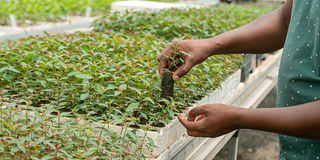Commercial forestry: From policy to action
Sponsored by Gatsby Africa

Tree seedlings ready for planting.
By Quiller Brooke and Elijah Munyi
Perceptions of commercial forestry are changing, with government shifts driving opportunities for growth. After realising the Vision 2030 target of 10 percent national tree cover, the government has extended its ambition to 30 percent by 2050.
Forestry is also expected to play a central role in reaching Kenya’s environment targets, with 53 percent of the country’s 43MTCO2 emissions fall coming from commercial forestry and agroforestry.
The Draft National Forest Policy, the Climate Change Action Plan, and the National REDD+ strategy, set out specific targets to realise these ambitions.
Private plantations are to be expanded by 150,000ha, re-stocking 31,000ha of public plantations and increasing productivity across 138,000ha of forests under the Kenya Forest Service (KFS).
The government is also implementing policies to grow agroforestry lots by 80,000ha. The shifting government attitudes are unlocking new opportunities, with public-private partnerships (PPP) playing a role.
By creating a transparent PPP framework to incentivise firms, individuals, and communities to invest in sustainable forest management, the government will be able to enforce high standards.
Private firms, individuals, and communities need to dedicate their land, capital and time to developing forestry opportunities. They require knowledge, capacity, and financial incentives.
The following changes will help capitalise on this opportunity.
Creating a shared vision
Public and private stakeholders should generate a shared vision for Kenya’s commercial forestry, what growth looks like for them, and agree on practical recommendations.
Like Vietnam’s 15-year Forestry Development Strategy (2006-2020), a shared vision can give stakeholders a clear understanding of the sector’s direction, allowing them to work with, rather than against new developments.
The Vietnam strategy tracked 72 economic, environmental and social indicators, providing metrics for success and highlighting areas limiting growth. By doing so, specific practical recommendations can be developed, ensuring a collaborative and efficient approach that accounts for the needs of players.
Developing a PPP framework
Creating a robust framework to facilitate the development of public-private partnerships will support investment while ensuring growth is inclusive, providing benefits to communities. Public consultation is needed before anything can be implemented to ensure buy-in into the suitability and community benefits to the PPP frameworks.
Public plantations have always been central to the processing industry. Creating a framework to return this resource to the market in a sustainable and socially inclusive way is key if the industry is to thrive.
Supporting growers
Private landowners hold the potential of transforming forestry. In Uganda, commercial plantations grew from just 4,000ha in 2003 to about 100,000ha today. Some 75 percent of these are on land owned by local small and medium-sized growers.
By supporting SMEs, benefits of the sector growth can be owned locally. Developing financial and insurance products tailored to the needs of growers and creating financial incentives that speak to specific constraints faced by the sector are some of the ways of doing this.
Meeting these investments with technical support services, their impact can be maximised.
Driving demand
The final piece of the puzzle is demand for Kenyan grown wood. In July 2022, Komaza launched Kenya’s first high-quality primary processing centre, sourcing directly from small growers.
By sparking demand for domestic wood, the farm forestry resource base can be pulled into the formal value chain, unlocking access to high-quality, relatively low-cost (compared to imported mahogany) kiln dried timber, and in turn, attract a new wave of investment into secondary processing.
The Buy-Kenya, Build-Kenya policy is expected to raise demand for locally-made furniture.
What success would look like
An analysis by Gatsby Africa shows that if developed to its competitive and inclusive potential, commercial forestry can drive significant socio-economic and environmental benefits for Kenyans, like it has in
Vietnam. The sector has the capacity to create 11,000 formal skilled jobs, and indirectly create 52,000.
Contributing an additional 5.4 million cubic metres of domestically grown wood to supplies yearly, growth would reduce Kenya’s dependency on imports and generate 197,000ha of additional commercial forestry coverage.
Creating a shared vision for the sector, facilitating PPP, supporting SMEs and driving demand for domestically grown wood will transform the policy shifts into opportunities for thousands.
__________________________________________________________
Brooke is the Deputy Director Learning and Partnerships at Gatsby Africa, Commercial Forestry Programme. Munyi is the Intervention Manager Policy and Insights at Gatsby Africa, Commercial Forestry Programme.
The article was first published in ‘MITI’ magazine. A complete coverage of the topic by the Seeds of Gold magazine of Saturday Nation is available here.


